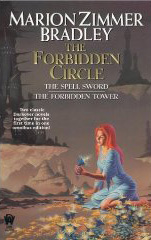The Forbidden Tower (1977) is the sequel to The Spell Sword (1974) and they’re in print in one volume as The Forbidden Circle. As with the Renunciates books, but even more so, this pair is an adventure story followed by a slow reflective consideration of the consequences of that adventure on the participants, with an afterthought of an action plot pinned on. In The Spell Sword Andrew Carr, a Terran who grew up on a ranch on Earth, comes unexpectedly into telepathic contact with Callista, the Keeper of Arilinn, who was captured by nonhuman catmen. They fall in love. At the same time Damon Ridenow, a telepath, soldier and younger son, falls in love with Callista’s sister Ellemir and organizes the exterior side of the war with the Catmen. In The Forbidden Tower, the four of them deal with their personal issues. It’s a book about marriage between four telepaths with cultural, magical and sexual issues. It’s a book that feels surprisingly honest and it works surprisingly well.
I think The Spell Sword would be a reasonable place to start the series and discover the world, but if you read The Forbidden Tower without having read it first I’m pretty sure you wouldn’t have any problems working out what had happened. They are written in very different registers.
One thing I noticed, going from the Renunciates books to these, is how very much these are books about the men. Although Callista and Ellemir (and Leonie Hastur) are important characters, we see them through the eyes of the men who love them. This is primarily a story about Terran Andrew coming to love Darkover and Darkovan customs (like wife-sharing and not being homophobic) and we’re only told how the women feel from outside.
In the broader story of Darkover, these are set at the same time as the Renunciate books and a generation before The Bloody Sun. The significant thing that’s going on is the beginning of matrix work being done outside the towers—teaching it to ordinary people who have laran, and using it to help ordinary people. The bit at the end of Thendara House that deals with the Forbidden Tower people concentrates on this acpect of what they’re doing. But The Forbidden Tower is a book about marriage and culture shock, and all of this is very much secondary—for most of the book it’s barely on stage.
There’s a plot, which has to do with Dezi, and unauthorized and irresponsible use of laran. Bradley remembers it just enough to keep it ticking over with events and a climactic battle. And there’s the real plot, which has to do with relaxing Callista’s programmed frigidity and Andrew coming to terms with what life on Darkover means. The (literal) climax to this second story is a little hurried.
I didn’t read these books as a teenager. (They mostly didn’t have British editions.) I read the whole lot of them in about a week in 1987 when I was storing some books for a friend, in old yellow-spined DAW copies. I therefore came to The Forbidden Tower long after reading Heinlein’s take on polyamory in The Moon is a Harsh Mistress and elsewhere. It wasn’t a new idea to me. Even though this is from the men’s point of view, it struck me then as a much more female angle on the issue, and a much more realistic one—Andrew at least finds it a culturally unusual thing and has problems with jealousy and understanding where the emotional lines are. It’s still idealised—and she’s quite sure telepathy would help, which I think reflects a touching faith in human nature. I think telepathy would make relationships almost impossible. But this is an interesting exploration of a subject that isn’t written about much at all.
Trivia question: What happened to all their children, as referenced at the end of Thendara House? We know about Cassilde and Cleindori, and that’s all. Valdir is Kennard’s father. Presumably one of their children is the father of Gabriel Lanart-Hastur in Heritage of Hastur, and perhaps one of them is Danilo’s mother?
Jo Walton is a science fiction and fantasy writer. She’s published eight novels, most recently Half a Crown and Lifelode, and two poetry collections. She reads a lot, and blogs about it here regularly. She comes from Wales but lives in Montreal where the food and books are more varied.










